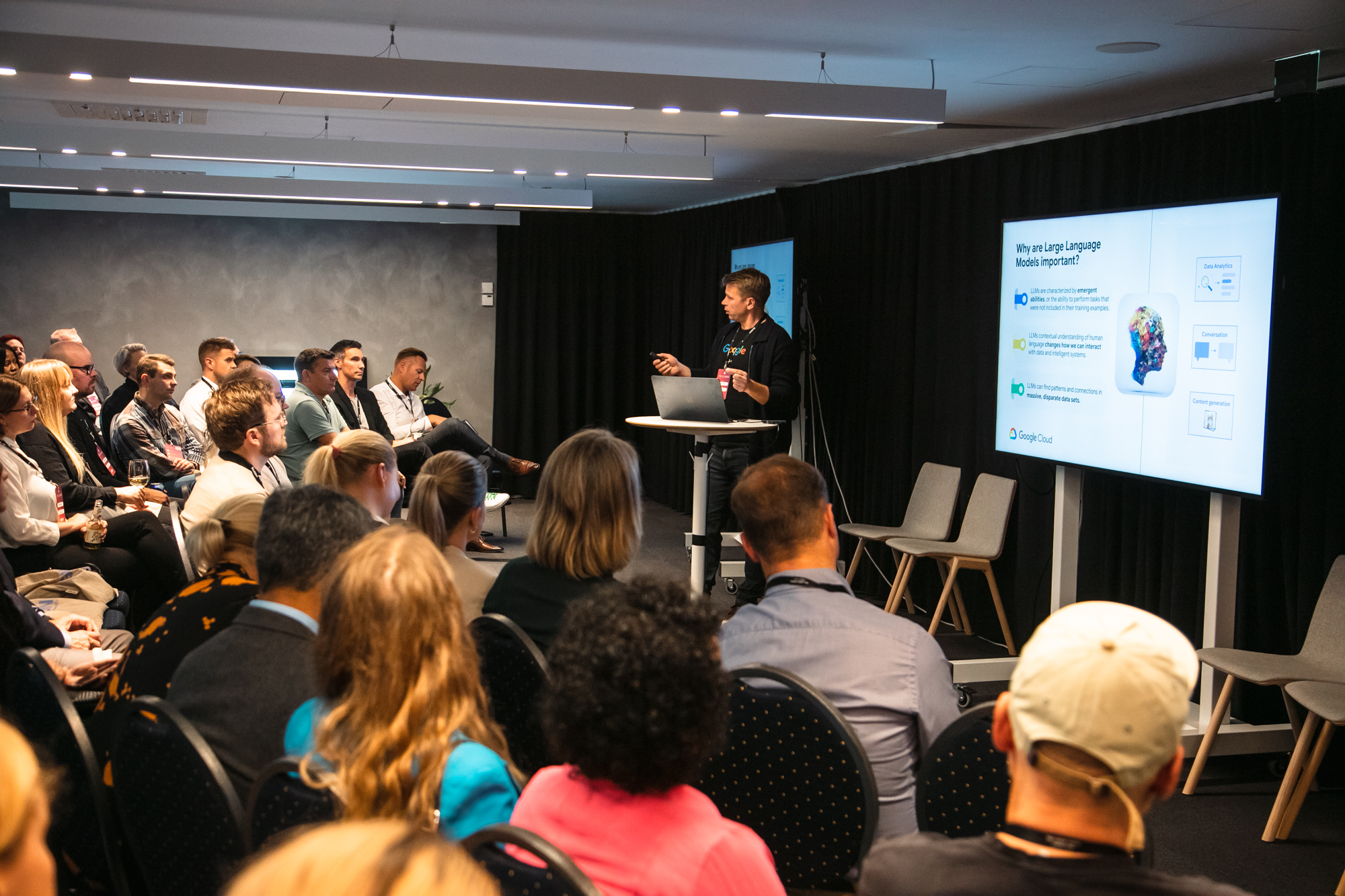What is required to lead successfully with AI?
From our blog / Article
In the world of business, the pursuit of innovation and transformation is a constant endeavor. Leading with AI requires driving business value through a commitment to continuous learning, cutting-edge innovation, and ethical data utilization

What is required to lead successfully with AI?
It is with immense satisfaction and a sense of accomplishment that we reflect on The AI Mixer, a pivotal event hosted by Fusion Ecosystem companies Nieve and GOODIN. This gathering brought together over 80+ visionary thinkers, each with a unique perspective and a shared commitment to exploring the boundless potential of artificial intelligence (AI) in shaping the future of business.
Top experts such as Google Cloud Finland’s Country Lead Markus Hongisto, Nieve’s co-founder and CTO Daniel Arroyo, 3StepIT’s CTO Juhani Rajala, and GOODIN’s co-founder and CFO Atte Ailio and co-founder and CMO Kira Sjöberg, provided some latest insights and shared their experiences in leading with AI.
The event offered a panoramic view of the current landscape while providing invaluable insights into the future of AI-powered enterprises putting productivity and scalability at the center. In this article we delve into the key takeaways from this future focused event and explore the path forward in leveraging AI for strategic advantage.

Tangible business value from AI
AI can bring tangible value to the table by enhancing decision-making, optimizing processes and refining products. With the right approach, AI can play a pivotal role in the future of decision-making. However, reaching the full potential requires leaders to focus on the right things.
Thus, the question that resonated throughout the event was, “What should leaders invest their time in to succeed with AI?” The consensus among both the audience and the speakers highlighted three critical areas that investing in wisely would prove useful:
- Skills and training: Prioritizing continuous upskilling and ensuring that teams possess the knowledge and motivation to excel in an AI-driven environment.
- Experimentation and innovation: Nurturing a culture where innovation thrives, and mistakes are viewed as valuable learning experiences.
- Ecosystem building: Strengthening relationships, fostering networks, and nurturing a collaborative spirit, both within the organization and externally.

Bridging the 'gap' between Business & IT
Bridging the gap between business and IT functions, and focusing on the essential building blocks of a data strategy were brought up as foundational requirements for AI success. This includes:
- Value creation: Asking the right questions and understanding the purpose and objectives of the data and/or AI strategy.
- Business users (ie “the people”): Emphasizing the role of human involvement in data-driven decision-making as the consensus was that data is only valuable when interpreted by skilled and context understanding professionals.
- Business and technology development: Recognising the forces that drive the realization of data strategy objectives.
- Soft principles for success: Promoting data empathy, ensuring data literacy across functions, and cultivating a robust data culture where decisions can be made in all roles and processes with the help of data.
- Hard principles for success: Embracing infrastructure essentials and appreciating the significance of security, data architecture, and efficient pipelines to provide a solid foundation for AI.


Catching the low hanging fruits
The event looked into finding some quick wins in the AI space. If the data infrastructure of an organization is in place, the utilization of GenAI becomes possible. Some examples of low-hanging fruit use cases are for instance:
- Sentiment analysis: Automatically sorting through product reviews to extract actionable insights.
- Report analysis: Automatically describing and summarizing business intelligence reports in natural language.
- Conversational search: Assisting customers in navigating product catalogs by understanding their intent.
- Chatbots: Enhancing customer service and pre-sales engagement with AI-powered agents.

Conclusion
The AI Mixer underscored the importance of driving business value through a commitment to continuous learning, cutting-edge innovation, and ethical data utilization.
The event highlighted the imperative for readers to foster a culture that seamlessly integrates business objectives with technological prerequisites for a successful data strategy. It also emphasized that it takes the people in the organization along on the ride, enabling them holistically as in the end nothing changes if people of an organization are not motivated to join the ride.
Only by cultivating a culture of conscious learning and principled data utilization, can organizations harness the productivity and scalability gains for business benefits. Powered by AI and GenAI.
The responsibility to champion this transformative journey starts with the vision of the C-level; when done right the potential rewards are boundless. However, without relevance and an embedded motivated data-culture cultivated throughout the organization, the task and the rewards will come in slowly or not at all.
Hence, embrace the future with confidence, for AI is not merely a tool; it is the gateway to a new era of business excellence – when your people know how to utilize it!

About the Authors
Co-founder of Fusion company GOODIN with a rich soon two-decade career. Kira Sjöberg has excelled in business design and people-centered change roles across diverse sectors. Her hallmark is a data-driven approach that seamlessly blends quality and quantity metrics. Kira's expertise transcends boundaries, leading transformative initiatives that harmonise data insights with human-centric strategies. Her adeptness in leveraging data for informed decision-making and fostering innovation has fueled operational excellence. Kira's core skills are in the orchestration of change, guided by an unwavering commitment to both analytical rigor and empathetic leadership.
Want to know more?
Connect with us.





